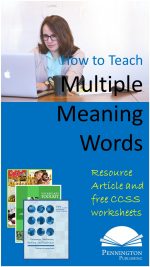
How to Teach Multiple Meaning Words
Multiple meanings matter. Can we learn how to teach multiple meaning words vocabulary to our students? I think so, and it’s important. For example,
From an old vaudeville act:
“You drove me to drink!” her husband shouted.
“No, you walked there yourself every night,” his wife responded.
This mildly humorous exchange is built upon word play. Word play is a basic tool for many writing and speaking genre. The word play in the short vaudevillian dialog involves the double-meaning of the verb, drove. It also involves different uses of the parts of speech: The husband uses to drink as an infinitive (an unconjugated verb). The wife interprets her husband’s word, drink, as a common noun place (say a bar) and the object of the prepositional phrase to drink (where). Finally, the husband uses the verb phrase, drove me to, as an idiom, meaning forced me or caused me, whereas the wife uses drove me as a colloquialism meaning he used the car to drive (no one drives a person).
Enough already! English-language arts teachers certainly can take the fun out of anything. My point is that multiple meaning words are important components of any language. English has plenty of them.
The Common Core authors include multiple meaning words in the Language Strand as Standard L.4.a., but word play is also included in word relationships Standard L.5.b. and figures of speech Standard L.5.a. By the way, I love the fact that the Standards include puns (my boldface):
CCSS.ELA-LITERACY.L.8.5
Demonstrate understanding of figurative language, word relationships, and nuances in word meanings.
CCSS.ELA-LITERACY.L.8.5.A
Interpret figures of speech (e.g. verbal irony, puns) in context.
See how multiple meaning words fit into the breadth of the Common Core Vocabulary Standards in the Language Strand:
- Multiple Meaning Words and Context Clues (L.4.a.)
- Greek and Latin Word Parts (L.4.a.)
- Language Resources (L.4.c.d.)
- Figures of Speech (L.5.a.)
- Word Relationships (L.5.b.)
- Connotations (L.5.c.)
- Academic Language Words (L.6.0)
What is the instructional focus of multiple meaning words?
Our instructional focus with multiple meaning words is centered on homonyms. A brief reminder: Homonyms represents a general category, literally meaning same names, that is used to indicate similar words which have different meanings. Homographs (words spelled the same, but pronounced differently, such as bass (a deep tone or voice) and bass (a type of fish), and homophones (words pronounced the same but spelled differently, such as reed and read) are subsets of homonyms. So, yes, bass, reed, and read are all examples of homonyms.
How do context clues fit in… the Standard does not mention these.
True, however words are always used in context. Without context clues, we wouldn’t understand homonyms. For example, saying “I like a lot of bass” is meaningless unless we surround the homograph with context clues, such as “I like a lot of bass on my speakers” or “I like a lot of bass, but not a lot of trout.”
As an aside, the Common Core Standards are quite explicit in some sections as exemplars for instruction; however, they are not a detailed instructional scope and sequence (see below for a helpful example). The Common Core authors expect teachers to use their brains to fill in the blanks. As an educational author, I always list applicable Standards; however, I also include a good measure of common sense. For example, the Language Strand Language Conventions Standards (L.2) include plenty of specific Standards regarding the use of different verb forms; however, the Standards nowhere mention “Thou shalt teach thine students what a verb is.”
Which Multiple Meaning Words to Use and How to Team Them
Students should practice grade-level homonyms (same spelling homographs and sound homophones) in context clue sentences which show the different meanings and function (part of speech) for each word.
Examples
In my five vocabulary programs (see below), I use vocabulary worksheets to help students learn grade-level multiple meaning words and context clue strategies to explain their use. Check out my S.A.L.E. Context Clue Strategies with free lessons HERE.

Multiple Meaning Words
*****
For full-year vocabulary programs which include multiple meaning words (L.4.a.), Greek and Latin morphology with Morphology Walls (L.4.a.), figures of speech (L.5.a.), words with special relationships (L.5.b.), words with connotative meanings (L.5.c.), and academic language words (L.6.0), check out the assessment-based grades 4, 5, 6, 7, and 8 Comprehensive Vocabulary.
Get the Grades 4,5,6,7,8 Vocabulary Sequence of Instruction FREE Resource:

Get the Greek and Latin Morphology Walls FREE Resource:

Get the Diagnostic Academic Language Assessment FREE Resource:

Grammar/Mechanics, Literacy Centers, Spelling/Vocabulary, Writing
Academic Language, academic language word lists, adages, affixes, colloquialisms, Common Core Vocabulary, Common Core Vocabulary Toolkit, connotations, consonants, context clues, conventional spelling, diagnostic spelling test, dictations, differentiate instruction, dramatic irony, eighth grade, encoding, fifth grade, figures of speech, flash cards, fourth grade, Greek, Greek and Latin, homographs, homonyms, homophones, idioms, intermediate, intervention, Latin, Mark Pennington, metaphors, middle school, multiple-meaning words, personification, phonics, prefixes, proverbs, puns, quizzes, reading comprehension, reading fluency, remediation, roots, seventh grade, shades of meaning, similies, situational irony, sixth grade, sound-spellings, spelling games, spelling inventory, spelling patterns, spelling programs, spelling rules, spelling skills, spelling sorts, spelling tests, spelling word sorts, spelling worksheets, spelling-vocabulary patterns, standardized test, structural analysis, syllable rules, syllable transformers, syllables, teachers, test preparation, verbal irony, vocabulary, Vocabulary Academic Literacy Center, vocabulary games, vocabulary programs, vocabulary review, vocabulary review games, vocabulary skills, vocabulary standards, vocabulary word sorts, vocabulary worksheets, vowels, within word, word attack, word lists, word recognition, word relationships, word sorts, worksheets










